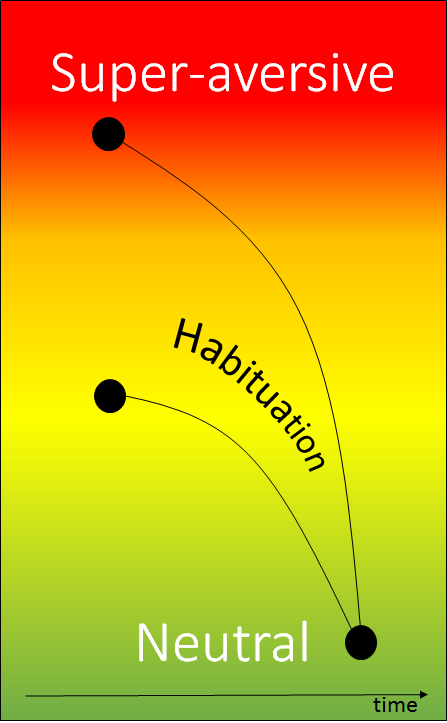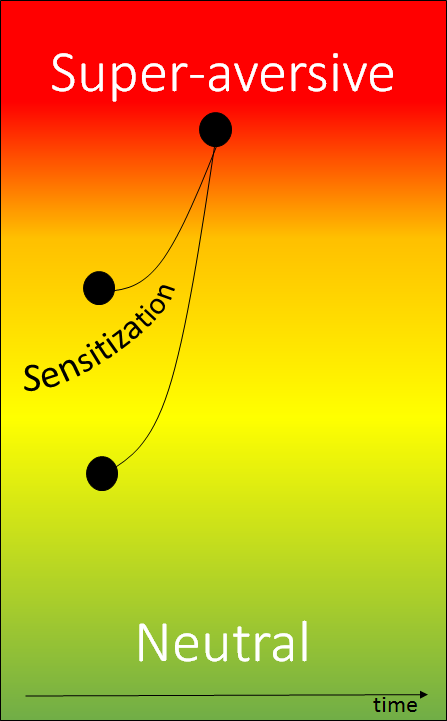If you’ve read my other posts in this series, you know I’ve been promoting counterconditioning (or re-learning) as one of the best techniques to reduce fear in the veterinary clinic.
You might be thinking: “Aaaaw, that’s too much of a hassle, there’s no time. Why not just grab the animal, do what needs to be done, and with time, the animal will get used to it? It will habituate.”
There are four reasons why I don’t think that’s a good idea:
- If it works, it’s a slow process
- Meanwhile, you risk injury in staff handling the animal and difficulty in diagnosis.
- You run the risk of sensitization (the animal becoming successively more fearful)
- You risk confusing successful habituation with learned helplessness (animals giving up; a potentially pathological reaction)
Stimuli could be rated according to valence (whether they’re pleasant / unpleasant) and range from super-nice to super-nasty in how they are perceived by the animal. What the animal actually thinks is unobservable, but behaviour will give us a cue – let’s assume behaviour correlates to valence, and look at one end of this continuum for a while.
For starters, sometimes it’s hard to know where on this scale different stimuli would rate. For some individual animals, moving through a crowded reception room may be really really aversive, for others less so, or not at all.

Habituation is simply exposing the animal to some stimulus until they stop responding. Conceptualized in our valence continuum, habituation brings stimuli to neutral over time or with repeated exposure, simply by exposure. What we actually observe is the animal reacting less and less to it. Habituation may occur with stimuli that are initially really aversive, or with stimuli that are not so aversive to begin with.
The first two problems are clear from this illustration: if we’re early in the process, the stimuli are aversive and behaviours will reflect that. Dogs may growl, cats may scratch, parrots may bite. Or worse. Even though later, they may stop responding, the initial exposures are risky and it may be difficult to properly examine (and thus diagnose) the animal.
What’s even more important is that it’s sort of like a lottery. Though habituation is one potential outcome of repeated exposure, sensitization is more likely in the vet clinic. Third problem.

If the animal sensitizes, what you’ll notice is that she starts responding more rather than less, over time or with repeated exposure.
Crucial differences between Habituation and Sensitization
Though they seem like two sides of the same coin, they’re not. Sensitization and habituation are different in a few ways:
- Habituation is slow, sensitization is potentially fast. Generally animals learn quicker about potentially dangerous stimuli.
- Habituation doesn’t generalize, sensitization does. Animals start reacting to other stimuli than the one that originally triggered the response.
- Habituation isn’t multi-modal, sensitization tends to be. Animals start reacting to other sensory stimuli than the original one: they get sensitive to noise, touch, visual input, etc.
The problem is that it’s hard to predict whether an animal will habituate or sensitize to a given stimulus. Some animals may sensitize even to not-so-aversive stimuli, others will not.
Judging by studies on how fear develops in animals visiting the veterinary clinic, the majority sensitize rather than habituate: dogs with previous negative experiences are more fearful than dogs with only positive previous experiences; older animals are more fearful than younger animals.
In this post, I’ve been assuming that we can tell by the animal’s behaviour how aversive a situation is.
But sometimes we can’t. Sometimes animals may stop struggling and meekly accept handling because it’s learned that resistance is futile. This is a potentially serious stress syndrome called learned helplessness. The fourth problem with attempting habituation in the vet clinic is thus telling successful habituation from learned helplessness.
Based on these thoughts, I’d advise against simply “getting it done” in the veterinary clinic.
Habituation alone won’t work.
Rather, I would suggest counterconditioning to reduce fear at the vet’s.
But, despite these shortcomings – there is still a nugget of gold hidden in the process of habituation. It’s a version of habituation called systematic desensitization– more about that in another post.
… Do you agree? Are there any more adverse effects of habituation that I didn’t mention? Let me know in the comment section below!
I give online courses about getting happy, reasonably well-behaved animals that thrive with people. Wanna learn more, and get information about when they’re available (and also get info about new blogposts and free webinars)? Sign up below!
References:
Döring et al., 2009. Fear-related behaviour of dogs in veterinary practice.


I like to use a pillow when I go to the vet. The pillow comes out for shots only. So I’m not the one associated with the shot.
I do give the pillow some value.
I use like a safety zone.
I would also like to just take the dog and pillow to vet for a know reason visit.
To help with predictors.
Go get out pee. Go inside say hi get a treat and leave.
So the pillow has been “charged” with value in another setting, and when it’s brought out at the vet’s it predicts shots? 🙂
Not uncommon to see these issues in horse training. Many trainers who use aversives think they are doing desensitization when in fact they end up with learned helplessness.
Sorry to hear that – hopefully we can help educate them, together!